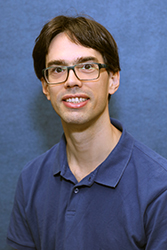
-
Aart Verhoef
- Assistant Professor
Biophotonics - Office:
- Heep Center 233C
- Email:
- [email protected]
- Phone:
- please email
- Graduate Education
- Ph.D. Ludwig Maximilian University of Munich, 2007
Professional Summary
Specialty: Biophotonics
Research:
Biophotonics encompasses all interactions of living organisms with light. In my research I use light to study biological processes. I develop novel techniques to image dynamic processes faster and to obtain information on the chemical composition of living tissues without the need to destroy the tissue or introduce fluorescent labels.
I apply fast imaging to insect brains in order to learn how some of their remarkable capabilities, such as night vision in nocturnal insects, can be translated to technology, to benefit society in general and agriculture specifically. In order to obtain information on the chemical composition of living tissues, we develop microscopy techniques based on coherent Raman scattering. With this we will study carbon sequestration in roots, transport of nutrients and waste products in leaves and stems, and detect plant-disease agents.
Graduate Students:
Brian Henrich | Riva Salzman